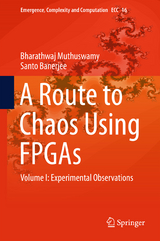A Route to Chaos Using FPGAs
Springer International Publishing (Verlag)
978-3-319-18104-2 (ISBN)
The purpose of this introductory book is to couple the teaching of chaotic circuit and systems theory with the use of field programmable gate arrays (FPGAs).
As such, it differs from other texts on chaos: first, it puts emphasis on combining theoretical methods, simulation tools and physical realization to help the reader gain an intuitive understanding of the properties of chaotic systems. Second, the "medium" used for physical realization is the FPGA. These devices are massively parallel architectures that can be configured to realize a variety of logic functions. Hence, FPGAs can be configured to emulate systems of differential equations.
Nevertheless maximizing the capabilities of an FPGA requires the user to understand the underlying hardware and also FPGA design software. This is achieved by the third distinctive feature of this book: a lab component in each chapter. Here, readers are asked to experiment with computer simulations and FPGA designs, to further their understanding of concepts covered in the book.
This text is intended for graduate students in science and engineering interested in exploring implementation of nonlinear dynamical (chaotic) systems on FPGAs.
Santo Banerjee was a senior research associate in the department of Mathematics, Politecnico di Torino, Italy from 2009-2011. Currently he is working as an Associate Professor, in the Institute for Mathematical Research (INSPEM), University Putra Malaysia, Malaysia, and is also a founder member of the Malaysia-Italy Centre of Excellence in Mathematical Science, UPM, Malaysia. His research is mainly concerned with Nonlinear Dynamics, Chaos, Complexity and Secure Communication. He has published 16 books and over 90 research articles in international journals in the field. Currently he is involved in many academic and industry projects on signal processing, biomedical measures and devices, complex networks and cryptography. He is an editor of EPJ Plus (Springer) and other journals publishing both regular and special issues. For more detail, please visit https://sites.google.com/site/santobanhome/ . Bharathwaj Muthuswamy received B.S (2002), M.S (2005) and PhD (2009) degrees from the University of California, Berkeley, all in electrical engineering and computer sciences. At present, he is a software engineer for Tarana Wireless.
Introduction.- Designing Hardware for FPGAs.- Chaotic ODEs: FPGA Examples.- Bifurcations.- Chaotic DDEs: FPGA Examples and Synchronization Applications.- Introduction to MATLAB and Simulink.- Chapter 1 MATLAB Code.- Chapter 2 VHDL, Simulink DSP Builder and SDC File.- Chapter 3 VHDL, MATLAB Code and ModelSim Scripts.- Chapter 4 MATLAB Code, VHDL and ModelSim Scripts.- Chapter 5 VHDL.- Glossary- Solutions.
| Erscheint lt. Verlag | 27.6.2015 |
|---|---|
| Reihe/Serie | Emergence, Complexity and Computation |
| Zusatzinfo | XXIII, 219 p. 131 illus. |
| Verlagsort | Cham |
| Sprache | englisch |
| Maße | 155 x 235 mm |
| Themenwelt | Technik ► Elektrotechnik / Energietechnik |
| Schlagworte | Chaotic Circuits Textbook • Complexity • Computer simulations for chaotic systems • field programmable gate arrays (FPGA) • Nonlinear Circuit Theory • Routes to Chaos • Simulation and Computational Tools for Chaotic Sys • Simulation and Computational Tools for Chaotic Systems |
| ISBN-10 | 3-319-18104-1 / 3319181041 |
| ISBN-13 | 978-3-319-18104-2 / 9783319181042 |
| Zustand | Neuware |
| Haben Sie eine Frage zum Produkt? |
aus dem Bereich




